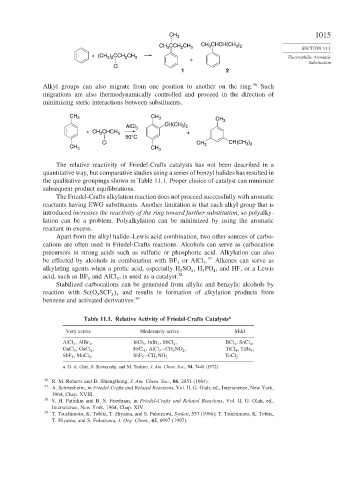Page 1039 - Advanced Organic Chemistry Part B - Reactions & Synthesis
P. 1039
CH 3 1015
CCH CH CH 3 CHCH(CH )
CH 3 2 3 3 2 SECTION 11.1
+ (CH ) CCH CH 3 Electrophilic Aromatic
2
3 2
+
Substitution
Cl
1 2
Alkyl groups can also migrate from one position to another on the ring. 36 Such
migrations are also thermodynamically controlled and proceed in the direction of
minimizing steric interactions between substituents.
CH
CH 3 3 CH 3
AlCl 3 CH(CH )
3 2
+ CH CHCH 3 +
3
50°C
Cl CH 3 CH(CH )
3 2
CH 3 CH 3
The relative reactivity of Friedel-Crafts catalysts has not been described in a
quantitative way, but comparative studies using a series of benzyl halides has resulted in
the qualitative groupings shown in Table 11.1. Proper choice of catalyst can minimize
subsequent product equilibrations.
The Friedel-Crafts alkylation reaction does not proceed successfully with aromatic
reactants having EWG substituents. Another limitation is that each alkyl group that is
introduced increases the reactivity of the ring toward further substitution, so polyalky-
lation can be a problem. Polyalkylation can be minimized by using the aromatic
reactant in excess.
Apart from the alkyl halide–Lewis acid combination, two other sources of carbo-
cations are often used in Friedel-Crafts reactions. Alcohols can serve as carbocation
precursors in strong acids such as sulfuric or phosphoric acid. Alkylation can also
be effected by alcohols in combination with BF or AlCl . 37 Alkenes can serve as
3
3
alkylating agents when a protic acid, especially H SO ,H PO , and HF, or a Lewis
2
4
3
4
acid, such as BF and AlCl , is used as a catalyst. 38
3
3
Stabilized carbocations can be generated from allylic and benzylic alcohols by
reaction with Sc(O SCF and results in formation of alkylation products from
3
3 3
benzene and activated derivatives. 39
Table 11.1. Relative Activity of Friedel-Crafts Catalysts a
Very active Moderately active Mild
AlCl 3 , AlBr 3 , InCl 3 , InBr 3 , SbCl 4 , BCl 3 , SnCl 4 ,
GaCl 3 , GaCl 2 , FeCl 3 , AlCl 3 −CH 3 NO 2 , TiCl 4 , TiBr 4 ,
SbF 5 , MoCl 5 , SbF 5 −CH 3 NO 2 FeCl 2
a. G. A. Olah, S. Kobayashi, and M. Tashiro, J. Am. Chem. Soc., 94, 7448 (1972).
36 R. M. Roberts and D. Shiengthong, J. Am. Chem. Soc., 86, 2851 (1964).
37
A. Schriesheim, in Friedel-Crafts and Related Reactions, Vol. II, G. Olah, ed., Interscience, New York,
1964, Chap. XVIII.
38 S. H. Patinkin and B. S. Friedman, in Friedel-Crafts and Related Reactions, Vol. II, G. Olah, ed.,
Interscience, New York, 1964, Chap. XIV.
39
T. Tsuchimoto, K. Tobita, T. Hiyama, and S. Fukuzawa, Synlett, 557 (1996); T. Tsuchimoto, K. Tobita,
T. Hiyama, and S. Fukuzawa, J. Org. Chem., 62, 6997 (1997).

